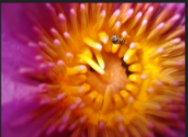
Explain the process of pollination in Vallisneria. How is it different in water lily, which is also an aquatic plant?
Answer
515.6k+ views
Hint:The process of transfer of pollen grains from the stamen to the ovule themselves or transfer of pollen grains from the anther to the stigma of a pistil is called pollination.
Complete answer:
Vallisneria is an aquatic plant. In case of vallisneria water is the agent for cross pollination. In female vallisneria the flower reaches to the surface of water by the long stalk and the male flower or pollen grains are released into the surface of water. Female flowers or stigma carried them by water current .

Water lily is also an aquatic plant with large coloured flowers but in them pollination occurs through wind or insects. The stigma or female flower images above the surface of water and gets pollinated . Insect pollination occurs in big sized coloured petals flowers. These flowers attract insects by offering them nectar.

Additional information:
Features of insect pollinated flowers
>Large and colourful flowers
>Nectar is rich in fragrance
>Small flowers form inflorescence to make them visible
>Some flowers secretes foul odour to attract flies and beetles
>The pollen grains are generally sticky and get stuck to the body of the pollinator.
Note:Pollination is of two types
1. Self pollination: when pollen grains transfer to another stigma of the same flower .then it is called self pollination. The anther and the stigma should be lie close to each other for self -pollination
2. Cross- pollination: it is the process of transferring pollen grains of one flower to the stigma of another flower.
Complete answer:
Vallisneria is an aquatic plant. In case of vallisneria water is the agent for cross pollination. In female vallisneria the flower reaches to the surface of water by the long stalk and the male flower or pollen grains are released into the surface of water. Female flowers or stigma carried them by water current .

Water lily is also an aquatic plant with large coloured flowers but in them pollination occurs through wind or insects. The stigma or female flower images above the surface of water and gets pollinated . Insect pollination occurs in big sized coloured petals flowers. These flowers attract insects by offering them nectar.

Additional information:
Features of insect pollinated flowers
>Large and colourful flowers
>Nectar is rich in fragrance
>Small flowers form inflorescence to make them visible
>Some flowers secretes foul odour to attract flies and beetles
>The pollen grains are generally sticky and get stuck to the body of the pollinator.
Note:Pollination is of two types
1. Self pollination: when pollen grains transfer to another stigma of the same flower .then it is called self pollination. The anther and the stigma should be lie close to each other for self -pollination
2. Cross- pollination: it is the process of transferring pollen grains of one flower to the stigma of another flower.
Recently Updated Pages
Master Class 12 Business Studies: Engaging Questions & Answers for Success

Master Class 12 Economics: Engaging Questions & Answers for Success

Master Class 12 English: Engaging Questions & Answers for Success

Master Class 12 Maths: Engaging Questions & Answers for Success

Master Class 12 Social Science: Engaging Questions & Answers for Success

Master Class 12 Chemistry: Engaging Questions & Answers for Success

Trending doubts
What are the major means of transport Explain each class 12 social science CBSE

Which are the Top 10 Largest Countries of the World?

Draw a labelled sketch of the human eye class 12 physics CBSE

Explain sex determination in humans with line diag class 12 biology CBSE

The pH of the pancreatic juice is A 64 B 86 C 120 D class 12 biology CBSE

Give 10 examples of unisexual and bisexual flowers




